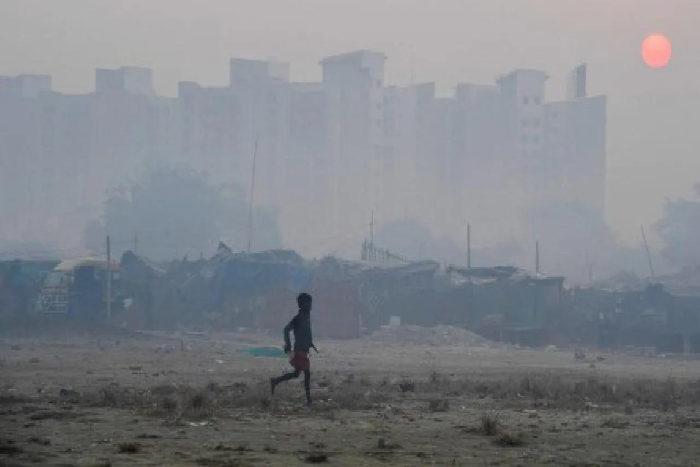A new study by IIT Delhi found that between 2001 and 2018, India lost 29% of its solar energy potential as a result of atmospheric pollution—equivalent to an annual loss of $835 million. According to an assessment by Mercom, by March 2022, India had only reached the halfway mark of 50 gigawatts of installed solar capacity, and air pollution has blocked the prospects for India to achieve the target of generating 100 gigawatts of solar power in 2022.
Speaking to SciDev.Net. one of the authors of the study, Sagnik Dey, said aerosols containing PM, dust, mist and fumes suspended in the air, significantly reduce incoming solar radiation in what is called the ‘atmospheric attenuation effect,'” which must be factored in when undertaking large solar energy projects.”
Scientists said solar projects are also failing to account for the “soiling effect” of aerosols depositing on panels, blocking solar radiation from reaching the photovoltaic cells. “Since air pollution over South Asia has been on the rise, both effects need to be addressed and mitigation steps taken to maximise benefits from solar power installations,” he added. Particulate matter can cause a drop in photovoltaic solar power generation by over 50%. Most of it caused the soiling of panels, according to a previous study.
Unusually high levels of ozone detected in Delhi-NCR air
Central forecasting body System of Air Quality and Weather Forecasting and Research (SAFAR) found unusually high concentrations of ozone in parts of Delhi between April 1 and April 11. The concentration was higher than the national standard of 51ppb. The AQI of ozone is calculated on the basis of eight sunshine hours daily, TOI reported.
SAFAR’s leading scientist Gufran Being said ozone pollution was high due to high temperature and a rise in volatile organic compounds (VOCs).
Ozone pollution is not directly emitted from any source, but chemically produced from NOx (nitrogen oxide) and VOCs in the presence of sunlight, Beig said, adding that VOCs can also be emitted from natural sources, such as plants. Scientists said ozone is a heat-trapping greenhouse gas. It not only builds up in cities, but also drifts long distances to form a regional pollutant that makes both local local and regional action necessary. This can inflame airways, make lungs prone to infection, aggravate asthma, emphysema, and chronic bronchitis and increase the frequency of asthma attacks, leading to increased hospitalisation, Beig added.
‘Air pollution worsened in India in 2021’, breaking 3-year stint of improving air quality
Particulate Matter 10 (PM10) rose in 31 cities in 2021 compared to 2020, the government informed Parliament. The fine particulate matter decreased in 96 cities and remained unchanged in four, according to the analysis of ambient air quality data from 132 non-attainment / metropolitan cities.
Meanwhile, a world air quality report by Swiss firm IQAir found India’s air pollution worsened in 2021, breaking a three-year trend of improving air quality. The average count of the lethal PM2.5 pollutant is 58.1 micrograms per cubic metre—10 times higher than the World Health Organization’s (WHO) air quality guidelines. Delhi was named as the world’s most polluted capital for the fourth consecutive year, with pollution rising almost 15% compared to 2020. Air pollution levels here were almost 20 times above the WHO’s safety limits, with PM2.5 clocking in at 96.4 micrograms per cubic metre for the annual average.
Bihar bans diesel vehicles in Patna and adjoining areas, 12,000 buses, 200 autos off road
To fight air pollution, the Bihar government banned diesel vehicles in Patna and neighbouring areas of Danapur, Khagaul and Phulwari Sharif from April 1. Commuters in Patna were badly impacted as the ban forced out 12,000 diesel auto-rickshaws and more than 200 diesel public transport buses off the road. Auto-rickshaw drivers failed to fit CNG kits because of their high prices. Bihar decided to stop diesel vehicles in 2019 in a bid to check rising air pollution, but the same could not be made effective at that time due to the COVID-19 pandemic.
Noida-Delhi residents brace for air pollution as 32-storeyed twin towers await demolition on May 22
The Uttar Pradesh Pollution Control Board (UPPCB) asked for periodic air quality reports at the site of the ongoing demolition of the massive 32-storeyed Supertech twin towers in Sector 93, Noida. The towers have to be raised on May 22 as per the Supreme Court’s February 7 orders.
Noida authorities have been asked to keep mechanical sweeping machines ready while residents in the neighbourhood have been advised to keep all doors and windows closed, switch off their ACs and cover the external units of their ACs so that the dust is not sucked in.
According to the HT report, the wind direction during May-June is usually easterly, which would mean that the wind will travel from Noida towards Delhi. Experts told the newspaper that the wind speed on the day will decide how far it will travel.
About The Author
You may also like
Delhi-NCR most polluted region in India, Karnataka the cleanest air in India: Report
Outdoor air quality chronically underfunded, finds State of Global Air report
PM2.5 shortening average life expectancy of Delhi residents by almost 12 years
PM 2.5 air pollution increases anti-biotic resistance globally, India risk increases 2.5%
Green court forms panel to release air pollution control norms around hospitals with in the next 3 months


